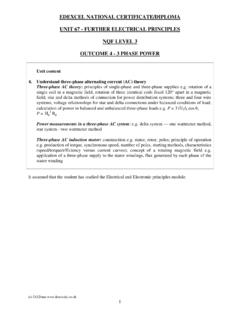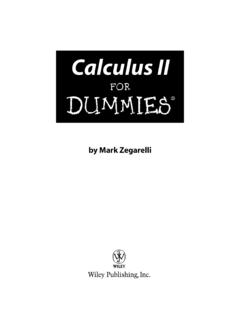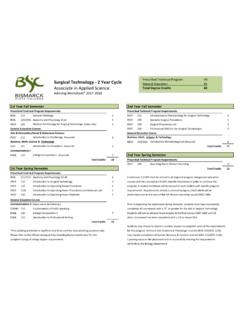Transcription of INTRODUCTION TO BEAMS - FREE STUDY
1 ENGINEERING COUNCIL. DIPLOMA LEVEL. MECHANICS OF SOLIDS D209. TUTORIAL 2 - STRESSES IN BEAMS DUE TO BENDING. This tutorial covers elements of the following syllabi. You should judge your progress by completing the self assessment exercises. On completion of this tutorial you should be able to do the following. Define a beam . Recognise different types of BEAMS . Define BENDING MOMENT. Derive the BENDING FORMULAE for BEAMS . Calculate the stress in a beam due to bending. Solve problems involving both bending and direct stress. Find the position of the neutral axis for combined stress situations. Solve problems involving simple composite BEAMS . It is assumed that students doing this tutorial already understand the basic principles of moments, shear force, stress and moments of area. Students must also be able to perform basic differentiation and calculus from their maths studies. 1. 1 TYPES OF BEAMS . A beam is a structure, which is loaded transversely (sideways). The loads may be point loads or uniformly distributed loads (udl).
2 The diagrams show the way that point loads and uniform loads are illustrated. A point load is a load or force that acts at a single point on a structure and it is depicted by a single arrow on diagrams. Figures 1a and b A uniform load is one which is evenly distributed along a length such as the weight of the beam or a wall built on top of a beam . It is depicted by a series of arrows as shown. We usually denote the loading as w N/m. Figures 1c and d The beam may be simply supported or built in. Figures 1e to 1g Transverse loading causes bending and bending is a very severe form of stressing a structure. The bent beam goes into tension (stretched) on one side and compression on the other. The complete formula which describes all aspects of M E. bending is . I y R. Figure 2. We will now look at the derivation and use of this formula. 2. 2. THE BENDING FORMULA. NEUTRAL AXIS. This is the axis along the length of the beam which remains unstressed, neither compressed nor stretched when it is bent.
3 Normally the neutral axis passes through the centroid of the cross sectional area. The position of the centroid is hence important. Consider that the beam is bent into an arc of a circle through angle radians. AB is on the neutral axis and is the same length before and after bending. The radius of the neutral axis is R. Figure 3. Remember the length of an arc is radius x angle in radians RADIUS OF CURVATURE. Normally the beam does not bend into a circular arc. However, what ever shape the beam takes under the sideways loads; it will basically form a curve on an x y graph. In maths, the radius of curvature at any point on a graph is the radius of a circle that just touches the graph and has the same tangent at that point. RELATIONSHIP BETWEEN STRAIN AND RADIUS OF CURVATURE. The length of AB AB = R . Consider figure 3. There is a layer of material distance y from the neutral axis and this is stretched because it must become longer. The radius of the layer is R + y. The length of this layer is denoted by the line DC.
4 DC = (R + y) . This layer is strained and strain ( ) is defined as = change in length/original length DC AB R y R y Substitute AB = R and DC = (R + y) . AB R R. The modulus of Elasticity (E) relates direct stress ( ) and direct strain ( ) for an elastic material and the definition is as follows. stress . E . strain . y R E . Substitute and E . R y R y It follows that stress and strain vary along the length of the beam depending on the radius of curvature. We will now go on to show that the radius of curvature depends upon the bending moment M acting at any given point along the length of the beam . 3. RELATIONSHIP BETWEEN STRESS AND BENDING MOMENT. Consider a beam with a consistent shape along its length. An arbitrary oval shape is shown here. Think of the beam as being made of many thin layers of material running the length of the beam and held together by molecular forces. Consider one such elementary layer at a given point along the length at a distance y from the neutral axis. When the cross section is viewed end on it appears as an elementary strip width b and thickness y.
5 Figure 4. The cross sectional area is A. The elementary strip is a small part of the total cross sectional Area and is denoted in calculus form as A. The strip may be regarded as a thin rectangle width b and height y so A = b y The stress on the strip is = Ey/R. If the layer shown is stretched, then there is a small force F pulling normal to the section trying to slide the layer out of the material in a lengthwise direction. This force must be the product of the stress and the area and is a small part of the total force acting on the section F. Ey Ey F A Substitute and F A. R R. Consider that the whole beam s made up of many such layers. Some are being stretched and pull normal to the section and some are compressed and push. The total force acting on the section is the sum of all these small forces. Ey F F A. R. In the limit as y tends to zero, the number of strips to be summed tends to infinity. The small quantities y and A become the differential coefficient dy and dA. The total force is given by the integration top top Ey E.
6 F dA y dA. bottom R R bottom top The expression y dA is by definition the first moment of area of the shape about the centroid. bottom Evaluating this expression would give zero since any first moment of area is zero about the centroid. The centroid in this case is on the neutral axis. The areas above and below the neutral axis are equal. Half the force is a compressive force pushing into the diagram, and half is tensile pulling out. They are equal and opposite so it follows that F = 0 which is sensible since cross sections along the length of a beam obviously are held in equilibrium. 4. Figure 5. The diagram indicates that the two forces produce a turning moment about the neutral axis because half the section is in tension and half in compression. This moment must be produced by the external forces acting on the beam making it bend in the first place. This moment is called the bending moment M. Consider the moment produced by the force on the elementary strip F. It acts a distance y from the neutral axis so the moment produced is M = y F.
7 In the limit as y tends to zero the total moment is found by reverting to calculus again. top top Ey M y F ydF y dA. bottom bottom R. top E. M y dA. 2. R bottom top y 2. The expression dA is by definition the second moment of area about the neutral axis and this is not bottom top I y 2. zero but has a definite value. In general it is denoted by the symbol I. dA. bottom E M E. We may now write the moment as M I and rearrange it to . R I R. E M E M E. Combining and we now have . R y I R I y R. This is called the bending equation and it has 3 parts. My Ey If the stress is required at a given point along the beam we use either or This indicates I R. that the stress in a beam depends on the bending moment and so the maximum stress will occur where the bending moment is a maximum along the length of the beam . It also indicates that stress is related to distance y from the neutral axis so it varies from zero to a maximum at the top or bottom of the section. One edge of the beam will be in maximum tension and the other in maximum compression.
8 In beam problems, we must be able to deduce the position of greatest bending moment along the length. 5. STANDARD SECTIONS. At this stage, don't worry about how M is found, it is covered later. For a given section the value of I may be determined by mathematics. Many BEAMS are manufactured with standard sections. British Standard BS4. part 1 gives the properties of standard steel BEAMS and joists. The areas and second moments of area are listed in the standards and since the distance y to the edge is also known they list a property called the I. ELASTIC MODULUS and this is defined as z . The stress at the edge of the beam is then found from y My M. the equation . I Z. For standard shapes the second moment of area can be deduced. This is covered in the pre-requisite tutorial on moments of area. The following formulae apply to standard shapes. Figure 6. For more complex shapes such as TEE and U sections, you will need to STUDY the pre-requisite level tutorial in order to solve the second moment of area.
9 There are computer programmes for solving beam problems. The Archon Engineering web site has many such programmes. WORKED EXAMPLE A beam has a rectangular cross section 80 mm wide and 120 mm deep. It is subjected to a bending moment of 15 kNm at a certain point along its length. It is made from metal with a modulus of elasticity of 180 GPa. Calculate the maximum stress on the section. SOLUTION. B = 80 mm, D = 100 mm. It follows that the value of y that gives the maximum stress is 50 mm. Remember all quantities must be changed to metres in the final calculation. BD3 80 x 1003. I x 10 6 mm 4 x 10 6 m 4. 12 12. M .. I y My 15 x 103 x 6. x 10 6 N/m 2. I x 10. 6. WORKED EXAMPLE A beam has a hollow circular cross section 40 mm outer diameter and 30 mm inner diameter. It is made from metal with a modulus of elasticity of 205 GPa. The maximum tensile stress in the beam must not exceed 350 MPa. Calculate the following. (i) the maximum allowable bending moment. (ii) the radius of curvature. SOLUTION.
10 D = 40 mm, d = 30 mm I = (404 - 304)/64 = x 103 mm4 or x 10-9 m4. The maximum value of y is D/2 so y = 20 mm or m M .. I y I 350 x 10 6 x x 10 -9. M 1503 Nm or M Nm y E.. y R. Ey 205 x 10 9 x R m 350 x 10 6. SELF ASSESSMENT EXERCISE 1. A beam has a bending moment (M) of 3 kNm applied to a section with a second moment of area (I) of 5 x 10-3 m4. The modulus of elasticity for the material (E) is 200 x 10 9 N/m2. Calculate the radius of curvature. (Answer km). 2. The beam is Q1 has a distance from the neutral axis to the edge in tension of 60 mm. Calculate the stress on the edge. (Answer 36 kPa). 3. A beam under test has a measured radius of curvature of 300 m. The bending moment applied to it is 8. Nm. The second moment of area is 8000 mm 4. Calculate the modulus of elasticity for the material. (Answer 300 GPa). 7. 3. COMBINED BENDING AND DIRECT STRESS. NEUTRAL AXIS. When bending alone occurs in a member such as a beam , the neutral axis passes through the centroid. The stress varies from top to bottom over the structure from a maximum tensile on one edge to a maximum compressive on the other.
















